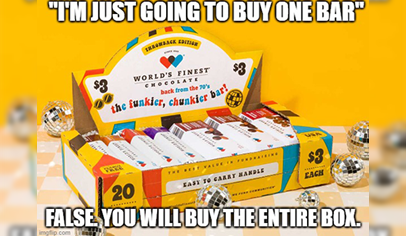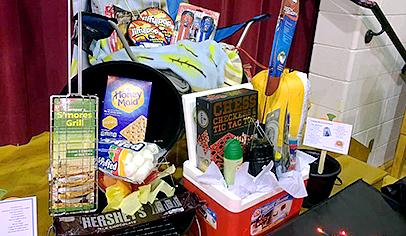1. Publicize Early and Often
Promotion before and during the sale is the key to successful fundraising. So in addition to the parent running the sale, identify a volunteer to act as the head cheerleader or spokesperson. Create a theme (such as “Reach for the Stars”) and a slogan (like “It only takes five!”) suggests Karen Grandinetti, president of Pure Profit Fundraising in Rio Rancho, N.M.
Alert parents ahead of time about the fundraiser. Montvale, N.J., schools do an email blast through the PTO website telling parents when a sale is starting and that they should look for a packet coming home. One of Grandinetti’s schools puts a whiteboard promoting the sale on an easel in the school office two months before the kickoff. It includes prices of the products to be sold so parents know what to expect. Other sources of promotion are lunch menus, newsletters, websites, outdoor signs, PA announcements, and the local newspaper.
Before and during the sale, emphasize the reason behind it. If you don’t, parents won’t feel compelled to take part. Butch Hinze has seen firsthand how much of a difference this can make. Hinze, the owner of Quality Wholesale in Carlisle, Pa., offers a cautionary tale from a cookie dough sale, “One school of about 400 kids had averaged $50,000 in sales for the past five years,” he says. “The lady in charge sent letters home, talked to parents at parents night. She said, ‘This is what we use the money for; this is why we need money.’ She got sample cookie dough, baked cookies, and put a bag with two cookies in it on every child’s desk in the school. When she left, the new person just passed out brochures. Sales dropped 40 percent.”
If allowed, you could even make the sale a part of the curriculum. In art class, students might draw pictures of what the money is being raised for, with these pictures sent home to parents or displayed in a prominent place at the school. As a math lesson, children might calculate profits based on sales.
During the sale, use automated calling to send recorded messages to students’ homes; even better, get the principal to record the message so parents know that he supports the sale. Track schoolwide participation with a poster-size thermometer. Grandinetti suggests building excitement with schoolwide rewards as a series of goals are reached, such as a crazy hat day, an extra recess, and a backward day. To spur individual participation, set an individual goal for students, such as five items sold. Whenever kids reach that goal, take their picture and post it on a Hall of Fame near the front office.
2. Limit the Number of Fundraisers
“Sometimes, the more products you put together, the more diluted the sale becomes,” says Leslie Marshall, director of fundraising for Interstate Batteries in Dallas. “Parents and the community feel pulled and tugged and will say, enough.” John Lavender, president and owner of Lavender’s, a fundraising company in Bolton Landing, N.Y., agrees. “Make supporters understand that you’re doing only one major fundraising sale,” he says. “Focus on better results with fewer fundraisers, and people are apt to buy more things.”
3. Promote the Product as a Gift
To get customers to buy more, emphasize a sale item as a potential gift. “Offer a product that not only would I use, but I’d be more than happy to give it to somebody as a present,” says Jim Boccia, national sales manager of Yankee Candle Company in South Deerfield, Mass. “Now they’re buying twice as much.” Plus, he says, people tend to buy more of something as gifts than they would buy for themselves.
4. Personalize the Product
Ask your fundraising company about the possibility of putting your own stamp on the product. This might be a slogan about the reason for the fundraiser, such as “Help us buy playground equipment,” or it might be a photo of the school. Holding a contest to choose the winning message or image can help pump up the excitement. “It engages the student sellers and gets the parents and teachers involved,” says Kimberly Paris, marketing manager for World’s Finest Chocolate in Chicago. “The product truly represents them.”
5. Try a New Product
If your fundraiser has become stale, consider selling something different. “Most schools don’t realize when they change up a product, that makes the sale fresh and new rather than old and stale,” Grandinetti says. Consider items you haven’t tried before or offer a variety of products. Evergreen Elementary in California, Md., chose a company with a catalog that included such items as flower bulbs, gifts for dogs, and faith-based items. “There were a lot of different things that would hit somebody’s interest,” says PTO president Jennifer McKay.
6. Switch the Timing of Your Fundraiser
Rescheduling a fundraiser may also boost sales. “A lot of people go with the same time of year they’ve always done, but I’ve switched a lot of people to November for improved sales,” says Kym Carder, a Zanesville, Ohio-based independent sales representative for Jose Madrid Salsa. And seek less obvious sales tie-ins beyond Christmas. Snack foods, for example, are big sellers before the Super Bowl, Carder says. Marshall says that batteries, which most people connect with Christmas, actually do better in early fall or early spring.
7. Use Creative Prize Incentives
To increase student participation, offer more prizes at lower sales levels, such as for selling one item, five items, and 10 items. If participation is already high but you want to generate more sales per student, then increase the number or quality of the prizes at the higher end, offering items like a bike, an iPod Shuffle, or a Nintendo DS Lite. To encourage timely submission of orders, you might allow students to grab for candy when they turn in their orders on time.
Offer additional prizes for certain milestones. For example, in addition to the regular prizes, everybody who sells five items might be eligible to draw for a cash prize ranging from $1 to $100 (with the PTO splitting the cost of these prizes with the fundraising company). “That motivates a lot of kids,” says Juan Franco, president of AIM Fundraising in Houston. “Everybody gets at least a dollar.” One variation is a money jump, in which the winner of a daily drawing gets to leap over a line of $5 bills to collect as many as possible.
In addition to prizes, top sellers might get special privileges, such as front-of-the-line passes, the role of principal for a day, or an invitation to a fancy lunch in the principal’s office. Some schools motivate students with the promise of a special event for the top-selling class, such as a pizza party, before-school breakfast, ice-cream social, or limousine ride. “Make kids feel special, that they did this for a reason,” Grandinetti says.
8. Involve Parents and Teachers
It’s not just students who are motivated by incentives. A PTO might reward the parent who helped the most with the sale with a special parking spot or front-row seats at a school program. For teachers, you might collect wish lists at the beginning of the school year and then award the teacher with the highest class participation the first item on his list. Or get the principal to offer teachers something of value. For example, teachers with 50 percent classroom participation could get a free blue jeans day, with additional rewards for 75 percent and 100 percent participation. At many schools, principals agree to do something wacky if a fundraising goal is met. Principals have dyed their hair the school colors, shaved their heads, and worn pajamas to school, for instance.
9. Rethink Your Sales Approach and Sales Territory
Don’t underestimate the power of young sellers. “Parents will take an order form to work and it just sits there; there’s not an immediate call to action,” says Marshall of Interstate Batteries. “It’s not nearly as effective as if the parent’s child came after school and walked around and asked people if they’d like to buy something. My dad was a postman, and when I was a kid I went to the post office and asked for sales from the mail carriers and the guys working the counter. They felt an obligation to support me.” Marshall also suggests expanding your sales territory to places likes churches and the courthouse. “Call on different leaders; go to the mayor’s office,” she says. Carol Rampey, president of UnitedScrip in Seneca, S.C., works with a group that sells $40,000 of scrip to a local nursing home, which buys it as Christmas gifts for employees.
Get Kids Motivated
To motivate students, use your imagination to come up with creative incentives. Here are a few ideas.
At Evergreen Elementary in California, Md., the class with the best sales in the PTO fundraiser was chosen to “adopt” a giant panda from the National Zoo in Washington, D.C. This adoption is actually a $65 donation to the zoo to fund exhibit improvement, new equipment, and medical care for the zoo’s animals. In return, the class receives a package that includes a stuffed panda, a photo of the zoo’s pandas, a certificate, and other items. “The students feel like they have a piece of an animal, and the teacher was incredibly excited,” says PTO president Jennifer McKay.
Also effective at Evergreen was the use of a mystery prize for each student who sold at least one item. Kids were curious to discover what they got, ranging from a really big eraser to a spinning game to a handheld plastic pinball machine. The top two sellers got $25 Toys R Us gift certificates in addition to the other prizes, no matter how many items they had sold.
Some PTOs tie incentives to the reason for the fundraiser. Carol Rampey, president of UnitedScrip in Seneca, S.C., says that one of her schools was raising money to build a library. So every time a child raised $15, he got to choose a library book and have his name printed in the front.
Make the sale itself fun. At Memorial Elementary in Montvale, N.J., 4th graders sold scented pencils to raise money for an art project. One thing that made the sale appealing was the funkiness of the product: The pencils came in varieties such as cotton candy and root beer. Another was that the 4th graders “felt like salespeople” as they circulated in the lunchroom among eager customers (other students), says Judi Catherwood, PTO president for Montvale schools.
A third reason was that the art teacher had kids excited about raising funds for an art project. Each child did a self-portrait that was transferred to a tile, which was then hung in a hallway of the school. The sale, which raised several thousand dollars, was so popular that the pencils had to be reordered several times, and the nearby middle school decided to sell the product, too.

























